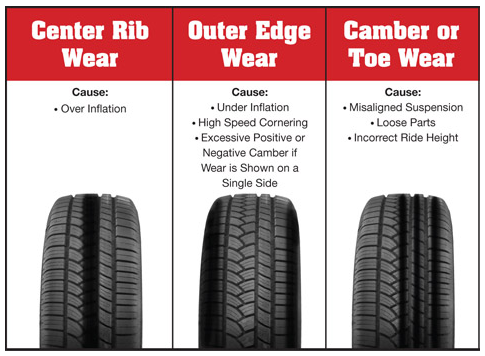One of the problems you can encounter when traveling by car is a punctured tire. Using a patch is a fairly common option to work around this issue.
Yet, if the hole is in a position like a tire wall, the problem becomes much more complicated because it is likely that the defensive position will not be patched.
So, how close to the sidewall can a tire be patched? A distance of 6 mm or more from the tire shoulder is required to fit a patch. In other words, if a crack is closer than 6mm, there’s almost nothing you can do about it!
Tire Sidewall OverviewFirst, let’s learn about sidewalls and how to identify them on your tires.
The wall is the rubber part from the outer edge of the rim to the road surface. This part also has the largest area, is the most flexible, and continuously deforms under loads when moving.
How Close To Sidewall Can A Tire Be Patched?As you know, the car’s wall is in a particular location, so it is pretty challenging to troubleshoot the hole here.
Manufacturers also recommend that you not choose the patch option if the spot is on the side of the vehicle or too close to this position. Then, how close to the sidewall can a tire be patched.
You cannot use the patch if the hole is close to the wheel with a gap of less than 6mm. In addition, you should note that if the hole is more significant than ¼ inch, the patch should not be used. In this case, if the patch is small, it cannot cover the hole, causing the wheel to deflate still when moving.
On the contrary, using a large patch can make the wheel more bulky, difficult to move, and unsafe.
Fix Sidewall DamageOther Related QuestionsTo better understand the problems that occur with the tires and how to overcome them effectively, you can refer to the following information.
We’ve put together some frequently asked questions that may help answer your questions on this topic.
Plug a flat tire: Is it possible?People are often concerned about whether it is safe to plug or patch a flat tire.
These two options are pretty standard in repairing or overcoming the problem of flat tires caused by rolling nails or other sharp objects.
The manufacturer still recommends that you better replace the tire with a new one when there is a problem because repairing with a plug or patch when a flat one is not a safe solution.
Yet, the cost of new tires is not cheap, and if you have this problem often, it is a big problem. So, many drivers use a plug or patch when a wheel is punctured.
There is a limit to the number of nails or patches on a product. You can use this option to temporarily fix the problem if you find a few small holes. If the wheel has many large holes or previous patches, it is best to replace it with a new one.
For a detailed guide, check out this video:
How close can a tire patch be to another patch?The gap between patches is also a topic that people are very interested in. When traveling on the road, you may encounter a flat one many times.
As you know, when the tires have had previous patches or punctures in close locations, it is better to replace them. In case
Can you patch a tire on the side of the road?In the case of a puncture on the tire side, the use of stickers is unlikely to have as much effect as you think.
The reason is that its wall adhesion is so thin that relatively few materials can adhere. More specifically, damage to the sidewall will seriously damage the structure of a wheel.
More specifically, damage to the sidewall will seriously damage the structure of a wheel.
The solution to this problem is to insert an extra tube inside the wheel to ensure that you can still turn the whole thing.
How fast can you drive on a patched tire?A patched one will not achieve the same speed and performance as it once was. Therefore, the optimal level you can expect from such a version will not be more than 85 mph. Of course, this is just the limit that many manufacturers recommend, but you should not overdo this limit.
Can you patch a tire with 2 nails in it?The answer is yes! It’s just that the gap between the two punctures is at least 16 inches, and you might seal them with two large patches.
According to many manufacturers, the maximum number of times performed is two times. If more than that, it’s time to get a new one.
ConclusionAs such, a puncture in the side of the vehicle is a unique location where patching is not an optimal solution in this case. It would help if you changed to a new tire to ensure safety when traveling.
It would help if you changed to a new tire to ensure safety when traveling.
Thank you for following this post!
This post was last updated onA tire breakdown on the go can indeed cause several troubles for you if you are in a hurry. Although the patch method seems to be the choice of many people, it does not apply to all punctures.
If you are having this problem, scroll down immediately. We’ve compiled all the information you need under one incredibly detailed insight, which is waiting for you to discover.
Table of Contents
How Close To Sidewall Can A Tire Be PatchedThe sidewall has never been an ideal part for applying hole patching. If the gap is 1″ pouring up, you can consider some measures to overcome or hold out temporarily until support is available.
Within 1″ of refills, any remedial efforts will be pointless, and you’ll need to buy a new tire to replace it.
In the below section, we have compiled the most specific information about the three types of surface damage you will encounter. These include sidewall, deadly wounds, and possible solutions. Scroll down for more information!
Understanding Sidewall PatchesIt’s best to learn more about the parts on the tire surface and their role in order to understand how serious the hole is.
If you look at the surface of this product, you will realize it consists of shoulders, crowns, and sidewalls. Inside it, sidewalls are located on either side of the tire to maintain the product shape. Shoulders firmly cover the crown. The hardest parts are the crowns, whose main role is contact and traction.
We want to remind you about these sidewalls more than other parts. They have a fairly smooth surface, consisting of many layers (depending on different models and manufacturers).
Structurally, most manufacturers use polyester as the main ingredient. Some places even reinforced the product with another layer of nylon.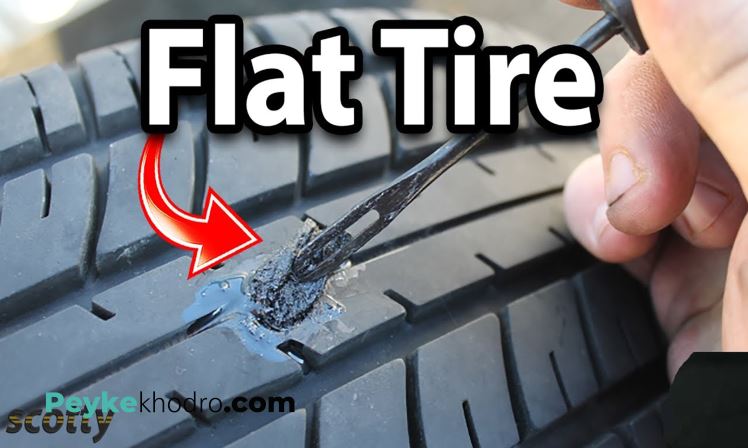 That’s why they give the entire tire an incredible amount of stability.
That’s why they give the entire tire an incredible amount of stability.
Still, it is the above structural features that make the punctures on the sidewall become fatal to the entire product. Once this part is damaged, it is impossible to repair it. In this case, your only choice is to remove the old one and replace it with the new one.
Deadly WoundsRegardless of the product’s model, the closer the puncture is to the sidewall, the slimmer your hope of repair. The sidewalls’ steel rings are difficult to repair, making the damage more fatal.
However, Once it’s 1″ or more away from the sidewall, you can safely find a remedy.
If you try patching a tire near the sidewall, you won’t be able to seal the holes completely. The humid outside air entering will destroy the tire quality from the inside. Once this goes on for a long time, tread separation is likely to happen unexpectedly to your vehicle.
Indeed, you may still be reluctant to take urgent measures. But this can only help your vehicle operate, and there is no guarantee of the distance behind.
But this can only help your vehicle operate, and there is no guarantee of the distance behind.
The performance of the car also decreased significantly. You will find out the decline in smoothness besides the decrease in speed.
Possible SolutionsSee more: How Long Does It Take To Patch A Tire
Sometimes, it is impossible to be able to find out relevant replacement parts on your journey. These extreme circumstances will force you to use a patch (or plug on the sidewall) or continue with a flat tire.
If you were in that situation, what would your options be? Our advice is to use temporary remedies until you reach the nearest auto repair station for those who are still wondering.
Driving for too long with a damaged tire will decrease the driving experience. Besides the decreased speed, the feeling of vibration is also another trouble it cause you.
This also causes minor damage to the overall performance of your tires. Though some tires with minor damage are still repairable and working properly, you might need to throw them away if you insist on moving on a flat tire.
Though some tires with minor damage are still repairable and working properly, you might need to throw them away if you insist on moving on a flat tire.
We suggest you cover them with a plug or a patch when the puncture is found at a safe distance from the sidewall. Considering tires with better bearing capacity will also reduce mid-road failures of this product.
If the hole is in the sidewall, all efforts to fix it are futile. It would be best to try to move to the nearest repair station and replace it with a brand-new tire.
How To Fix The Sidewall Damage?Let’s start by removing the tire from the wheel. Then, you need to use specialized tools to disassemble the fixing nuts.
After successful disassembly, check for holes and remove every stuck object (such as screws, dead branches, or nails). Completely remove the air in the tire and give a little cement to the plug.
Next, you need to clean the puncture and refill its air. After applying a sufficient amount of sealant to the plug’s center, plug it in to complete the patching process.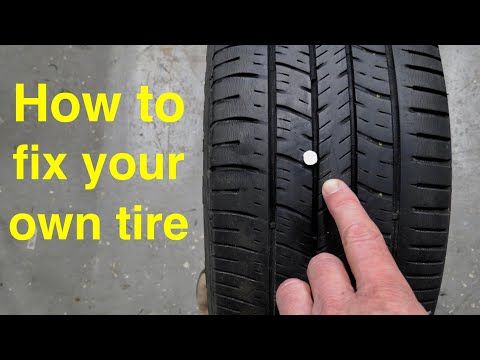
Cut the excess ends of the plug on the outside, then reinstall the wheel and inflate the product. The last step you need to complete is fixing the nuts and shooting the tire to the wheel tightly.
FAQSHow Long Can You Drive on a Patched Tire?See more: How Much Does It Cost To Patch A Tire
Our answers are sure to amaze you! A patch, if done properly, can last from 8 to 1 year. But the quality and durability will go down if you do this measure many times.
This measure will not guarantee you the same performance, speed, and smoothness. You would still face the risk of blowouts and damage along the way. Therefore, you should consider getting a new tire for the safest travel experience.
Can You Patch A Tire On The Side Of The Road?If you are facing this problem, it would be best to combine patching with another reinforcement measure.
Patches can be helpful with punctures that are easy to fix but are not so effective on the tire side. Therefore, the best way is to insert an extra tube inside the wheel to maintain the product shape in the best way.
Therefore, the best way is to insert an extra tube inside the wheel to maintain the product shape in the best way.
If you patch your product properly, it can still give you the ideal speed experience. Specifically, you can hit 80 mph with a patched product.
Our Final ThoughtsWe surely do not expect to encounter vehicle problems during their journey. Once that happens, understanding and mastery of the new approach is the key to solving your problem quickly and efficiently.
Through this article, we believe that the answer and all the problems related to it are no longer a headache for you. See you in the next articles.
esportby.com
An easy way to quickly restore tire tightness and continue your journey. True, for this you need to have the right wheel repair kit with you.
Maxim Stroker
“Catching” a nail, screw or piece of wire in a wheel on the track is a trifling matter and somewhere even everyday. However, it turns into a serious "trouble" if this happens, for example, at night or a couple of tens of kilometers from the nearest tire fitting point. In theory, in this case, you need to put a spare wheel and go further. Although, in the case of a family trip on vacation, the process of digging it out from under a pile of junk in the trunk can turn into an adventure that deserves a separate story. Be that as it may, often the trouble does not come alone and the spare tire can be broken literally on the next kilometer. After all, where one carnation fell on the road, there may well be another one, and another, and another ...
With a couple of crippled wheels, you'll either have to wait an unknown amount of time for a tow truck to be sent in, or fix it yourself. Therefore, in a not particularly urbanized area, it makes sense to carry a repair kit with you to eliminate punctures in tubeless wheels. In principle, it can be of any manufacturer. The main thing when choosing it in the store is to make sure that the “drill” included in the repair kit is not very toothy and sharp. After all, his task is simply to clear a puncture hole in the tire, and not to break its metal cord. The second recommendation: the flagella, which are supposed to close the puncture hole, should be plump and reinforced with thin wire or plastic threads.
In principle, it can be of any manufacturer. The main thing when choosing it in the store is to make sure that the “drill” included in the repair kit is not very toothy and sharp. After all, his task is simply to clear a puncture hole in the tire, and not to break its metal cord. The second recommendation: the flagella, which are supposed to close the puncture hole, should be plump and reinforced with thin wire or plastic threads.
n-i.kiev.ua
And the third criterion for choosing a wheel repair kit is the obligatory presence of a tube of glue in it. Yes, yes: there are also “glueless” sets on sale, which are essentially useless.
So, we notice that the wheel is flat (or has already been blown off) and proceed to eliminate the problem. Most often, the hole in the rubber is not visible. Therefore, to begin with, we hang out the damaged wheel by raising the car on a jack, and inflate it with a pump or compressor to 3-4 atmospheres. If even after that it is not possible to detect damage by the whistle of escaping air, we methodically and consistently wet the entire surface of the wheel and look for bubbles at the puncture site.
Having found a puncture, we take the “drill” from the set and pierce the damaged area with it several times. So we clean the surface of the hole before gluing. Next, we smear the “drill” with glue from the set and again immerse it in the hole. We repeat this operation and, leaving the “drill” sticking out in the hole smeared with glue, we take out the flagellum and insert it halfway into the eye of another tool - the “overgrown needle” (sometimes called the “awl”), also available in the repair kit. We coat the flagellum with glue and, quickly pulling the “drill” out of the hole, insert our “needle” there so that the ends of the flagellum remain above the surface of the wheel tread. Next, we pull out the “needle-awl” and wait a few minutes until the glue grabs. After that, we pump up the wheel and carefully cut off the protruding tails of the flagellum with a knife. Everyone, you can move on.
Test drive of one of the best family minibuses
19917
 Zen
Zen wheels, summer tires, cheap cars, repairs, tires, winter tires, track
Category: Operation and maintenance
Article reading time: 5 minutes
Bookmark this
A car tire has a complex structure and a specific rubber compound that protects the tire from impacts and retains its shape under high loads. The design of the wheel consists of several strength frames - metal wire and nylon thread, they keep the rubber on the trajectory during intense and dangerous driving.
Any type of damage can result in negative consequences that affect driving safety and road safety. And if the majority of punctures can be repaired in the service or repaired by oneself, then the side cut of the tire often forces one to resort to a complete tire replacement. Riding on damaged tires in the usual mode is extremely dangerous. How to fix a tire so that you can ride comfortably without consequences, and is it possible to seal or repair a cut tire? We will answer these and other relevant questions for motorists in this material.
Riding on damaged tires in the usual mode is extremely dangerous. How to fix a tire so that you can ride comfortably without consequences, and is it possible to seal or repair a cut tire? We will answer these and other relevant questions for motorists in this material.
Modern service centers can repair a tire after a front or side puncture. You can repair a tire, thanks to the universal set of a motorist, with your own hands. It is enough to seal the hole with a special tourniquet.
Is this type of damage dangerous and should it be replaced? Only the master can unambiguously answer the question, having studied the lateral damage. The specialist will determine the nature of the puncture that needs to be repaired and offer a complete tire replacement or repair. It is inexpedient and dangerous to close up a large puncture, due to which the tire is deformed.
To determine how to close a side cut, you need to study the type of damage:
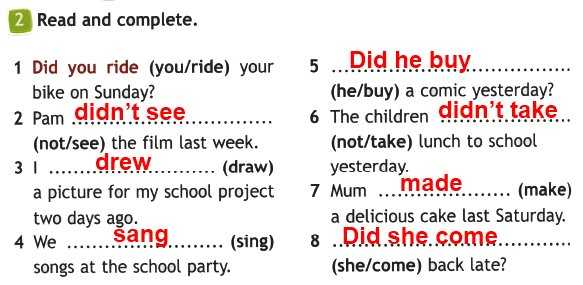
Sealing a cut on a tire is much more difficult than a normal repair, so it is often necessary to perform an involuntary replacement of tires. Repairing the wheel is impossible due to side wires and threads that break under side load. Taping and repairing lateral damage will not help repair the threads. Any obstacle or potential contact with a bump at high speed will have the adverse effect of bursting the tire due to the load, resulting in a dangerous loss of control.
A side cut is less dangerous than a longitudinal cut. However, not every defect requires replacement. Masters will be able to repair tires if the deformed area placed along the carcass threads does not exceed 50 mm. The possibility of repair is also available if the side cut located across the tire threads is less than 30 mm.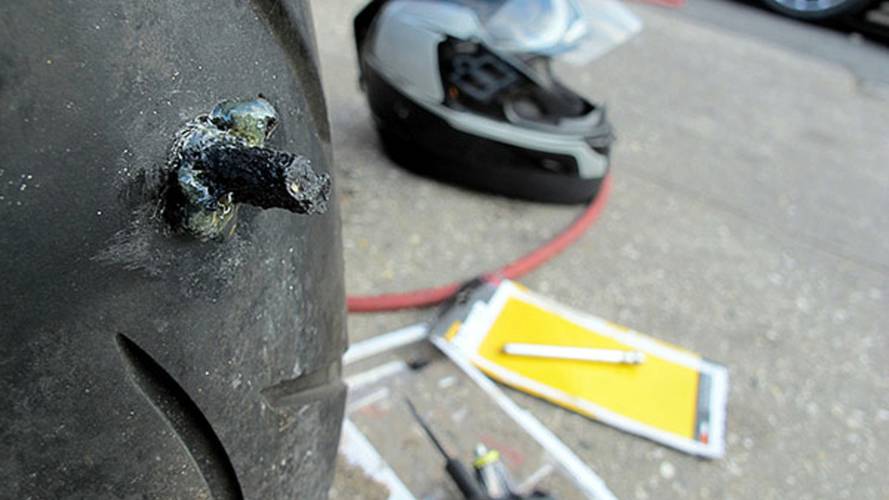 However, we do not recommend doing repairs in this case with your own hands. To preserve the protective properties and avoid possible negative consequences, it is necessary to use professional equipment.
However, we do not recommend doing repairs in this case with your own hands. To preserve the protective properties and avoid possible negative consequences, it is necessary to use professional equipment.
Should cuts be repaired? A popular question for motorists who are faced with a choice is whether to seal a defect or replace a wheel. The possible consequences of cuts scare car owners, but do-it-yourself repairs are more attractive because they are cheaper than buying fresh tires.
To avoid dangerous consequences, sealing small and large side cuts is prohibited if you need to repair more than 10 cords and close up a hole larger than 30 mm. It is possible to repair tires for passenger cars with a side cut of the tire if it is a shallow scratch.
Driving with a cut in a tire is not safe. The degree of risk depends on the nature of the damage and the experience of the specialist who will seal the seam. Before sealing the hole with your own hands or entrusting a restoration to a specialist, you should examine the lateral damage.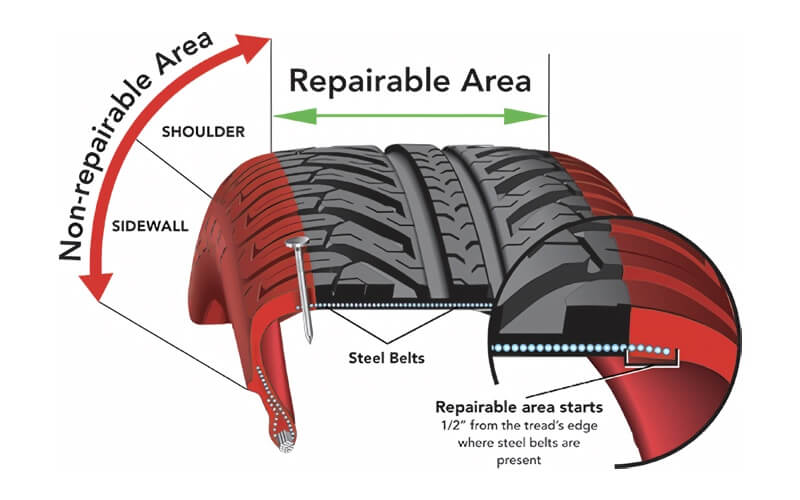 Manufacturers recommend replacing tires if it is necessary to seal 20 mm or more. However, if it is possible to change a wheel, the opportunity should be taken as soon as possible. Since even a small defect is dangerous during the trip. During operation, a hernia is formed, which explodes if timely replacement is not made. If you drive on a tire with a side cut for a long time and do not do repairs in the service or with your own hands, there is a high risk of getting into an accident.
Manufacturers recommend replacing tires if it is necessary to seal 20 mm or more. However, if it is possible to change a wheel, the opportunity should be taken as soon as possible. Since even a small defect is dangerous during the trip. During operation, a hernia is formed, which explodes if timely replacement is not made. If you drive on a tire with a side cut for a long time and do not do repairs in the service or with your own hands, there is a high risk of getting into an accident.
In order to strengthen the construction of tires, manufacturers add several layers of metal cord to models. Also on the market there is a fabric cord, which includes fibers from nylon, which allows you to increase the strength of rubber. Therefore, in order to seal the tire in the service or repair it yourself in case of a puncture, it is necessary to use high-quality materials. If the recommendations for replacement are not followed, there is a high risk of dangerous and unpredictable consequences.
Winter Disc protection
Tires Goodyear UltraGrip Arctic 2 SUV
Winter Drive Protection Sound Comfort
Rating:
4.5
Tires Goodyear UltraGrip Ice 2
Winter Disc protection
Tires Goodyear UltraGrip Performance+ SUV
Winter Disc protection
Tires Goodyear UltraGrip Arctic 2
Winter Drive Protection Run On Flat Sound Comfort
Tires Goodyear UltraGrip Performance+
To accurately assess the effects of tire deformation, before repairing a tire, contact a specialized center. The masters will figure out whether it is possible to continue driving a car or whether it is worth replacing the rubber. The main inspection criterion is the width of the seam that needs to be repaired. It should be borne in mind that it is dangerous to close up and seal holes with a width of more than 40 mm with rubber mixtures.
The masters will figure out whether it is possible to continue driving a car or whether it is worth replacing the rubber. The main inspection criterion is the width of the seam that needs to be repaired. It should be borne in mind that it is dangerous to close up and seal holes with a width of more than 40 mm with rubber mixtures.
If the craftsmen decide to restore the tire and make a patch, then the restoration process includes the following steps:
